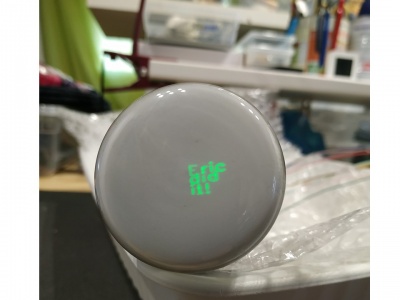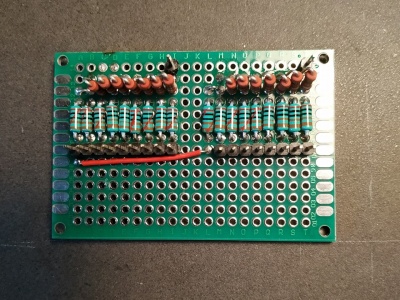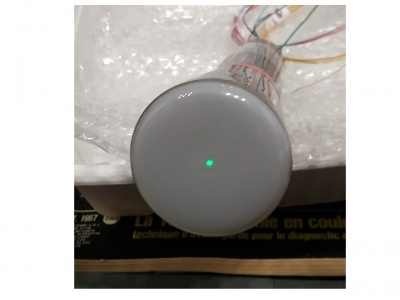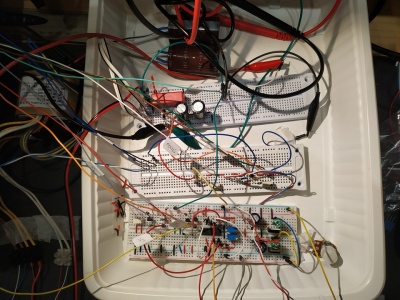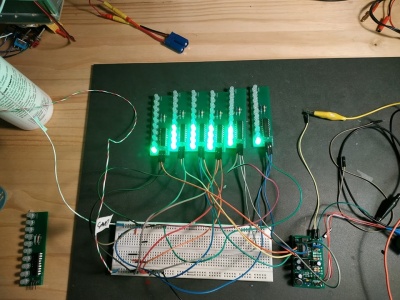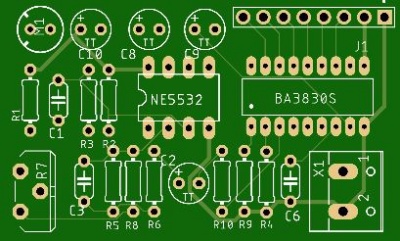Quoi de neuf 2021
From Eric
(Difference between revisions)
m |
m |
||
| Line 3: | Line 3: | ||
== February 2021 == | == February 2021 == | ||
| - | * I have received | + | * 2021/02/21 - I have managed to drive my CRT! To display text, I combined the Hershey's font definition provided at http://paulbourke.net/dataformats/hershey/ (slightly adapted), and the line plotting code from Alan Wolke (weaew). First, I used an Arduino fitted with two MCP4725 DACs: |
| + | [[File:crt_green_text_mcp4725.jpg|400px|thumb|none]] | ||
| + | ** The refresh rate was much too slow and we could see the display refresh even with 5 characters displayed. So I built a 8-bit DAC using a R2R resistor ladder: | ||
| + | [[File:resistorladder.jpg|400px|thumb|none]] | ||
| + | ** But the Arduino was in any case a bit slow. So I switched to an ESP32 (with two cores: one to refresh the display and the other to run some game...). And I discovered that the ESP32 has two DACs (connected to pin 25 and 26)! | ||
| + | |||
| + | |||
| + | * 2021/02/14 - I have received my russian CRT and have built the power supplies and the plate drivers. See article [[osciloscope]]. Here are a few pictures of the current setup: | ||
[[File:crt_green_dot.jpg|400px|thumb|none]] | [[File:crt_green_dot.jpg|400px|thumb|none]] | ||
[[File:crt_setup.jpg|400px|thumb|none]] | [[File:crt_setup.jpg|400px|thumb|none]] | ||
| - | * I have completed my "sound spectrum analyser" using a BA3830 and a bunch of LM3914N. A video is available [https://www.youtube.com/watch?v=G8x3ySQlx2E here] (definitively non interesting). The PCBs have been built by JLPCB (nice and fast. A few pictures are at [[Sound spectrum analyzer]]. | + | * I have completed my "sound spectrum analyser" using a BA3830 and a bunch of LM3914N. A video is available [https://www.youtube.com/watch?v=G8x3ySQlx2E here] (definitively non interesting). The PCBs have been built by JLPCB (nice and fast. A few pictures are at [[Sound spectrum analyzer]]. [[File:sound_spec_anal_live.jpg|400px|thumb|none]] |
* I have added a Python MQTT client to log the temp, humidity, pressure, etc. data to a mysql database. I use "sqlbrowser" to display the content of the data base. If I find some time, I'll write a Python HMI. Another solution would be to use an InfluxDb database (optimized for time series) and a Grafana dashboard. See tutorial [https://diyi0t.com/visualize-mqtt-data-with-influxdb-and-grafana/ here]. I should also probably move to a more robust RPi distribution (e.g., dietpi) in order to prevent the nasty effect of power-cuts on the file system (dietpi allows to set parts of the file system read-only). | * I have added a Python MQTT client to log the temp, humidity, pressure, etc. data to a mysql database. I use "sqlbrowser" to display the content of the data base. If I find some time, I'll write a Python HMI. Another solution would be to use an InfluxDb database (optimized for time series) and a Grafana dashboard. See tutorial [https://diyi0t.com/visualize-mqtt-data-with-influxdb-and-grafana/ here]. I should also probably move to a more robust RPi distribution (e.g., dietpi) in order to prevent the nasty effect of power-cuts on the file system (dietpi allows to set parts of the file system read-only). | ||
Revision as of 09:25, 21 February 2021
Experiments carried out in the past (from 2011) are described hereafter: 2020, 2019, 2018, 2017, 2016, 2015, 2014, 2013, 2012, 2011
February 2021
- 2021/02/21 - I have managed to drive my CRT! To display text, I combined the Hershey's font definition provided at http://paulbourke.net/dataformats/hershey/ (slightly adapted), and the line plotting code from Alan Wolke (weaew). First, I used an Arduino fitted with two MCP4725 DACs:
- The refresh rate was much too slow and we could see the display refresh even with 5 characters displayed. So I built a 8-bit DAC using a R2R resistor ladder:
- But the Arduino was in any case a bit slow. So I switched to an ESP32 (with two cores: one to refresh the display and the other to run some game...). And I discovered that the ESP32 has two DACs (connected to pin 25 and 26)!
- 2021/02/14 - I have received my russian CRT and have built the power supplies and the plate drivers. See article osciloscope. Here are a few pictures of the current setup:
- I have completed my "sound spectrum analyser" using a BA3830 and a bunch of LM3914N. A video is available here (definitively non interesting). The PCBs have been built by JLPCB (nice and fast. A few pictures are at Sound spectrum analyzer.
- I have added a Python MQTT client to log the temp, humidity, pressure, etc. data to a mysql database. I use "sqlbrowser" to display the content of the data base. If I find some time, I'll write a Python HMI. Another solution would be to use an InfluxDb database (optimized for time series) and a Grafana dashboard. See tutorial here. I should also probably move to a more robust RPi distribution (e.g., dietpi) in order to prevent the nasty effect of power-cuts on the file system (dietpi allows to set parts of the file system read-only).
January 2021
- I have moved my lab to a new, much larger, room:
- Waiting for the transformer to drive an CRT (see Quoi de neuf 2020, december).
- I have created a LED "spectrum analyzer" using an electret microphone, a 5532 op amp (see here), a BA3830S spec. anal., and a LM3914 LED display driver. Nothing very complicated, but just a way to occupy time. Here is a picture of the breadboard setup: , the scheme and the PCBs .
- I am also playng with my cubecell. I have attached a solar panel, a battery, and a CJMCU-8128 set of sensors. The guy transmits it data via LORA to a ESP32 which ralays them to a MQTT Mosquitto server running on an RPi...
